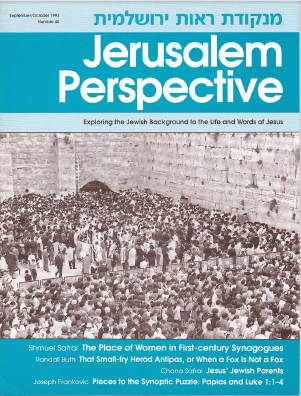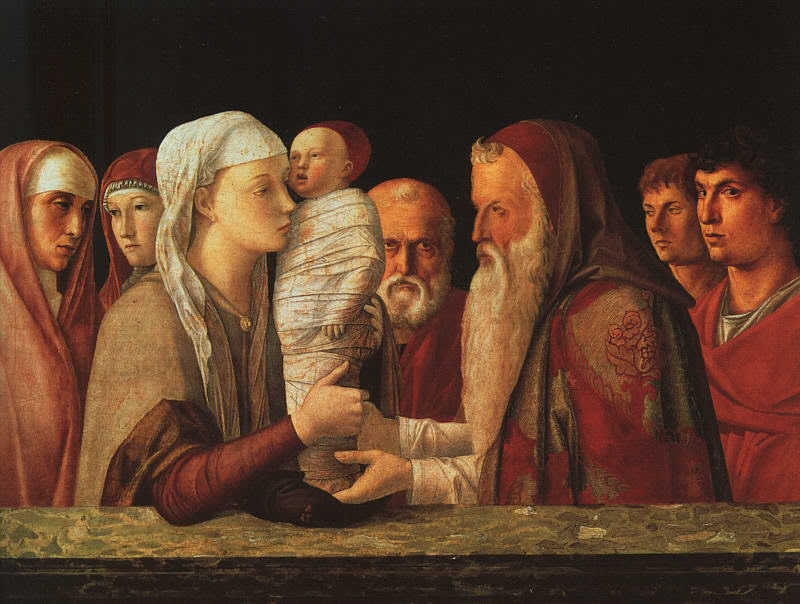How to cite this article: Chana Safrai, “Jesus’ Devout Jewish Parents and Their Child Prodigy,” Jerusalem Perspective 40 (1993): 10-11, 14-15 [https://www.jerusalemperspective.com/2673/].
John the Baptist was born to Zechariah and Elizabeth, and on the eighth day the neighbors and family gathered to celebrate the baby’s circumcision (Luke 1:57-58). On this occasion, John was given his name (Luke 1:59). Jesus also received his name at his circumcision: “On the eighth day, when it was time to circumcise him, he was named Jesus” (Luke 2:21).
Circumcision on the eighth day is a biblical commandment (Lev. 12:3; Gen. 21:4), but the public naming of a baby boy on the eighth day and the gathering of family and acquaintances to celebrate the occasion are Second Temple-period Jewish customs.[1] These two customs, attested in the gospel of Luke for the first time, are still common in Jewish practice.
Two More Ceremonies
Luke mentions two other Jewish customs (Luke 2:22-24) observed by Jesus’ parents: Mary’s offering of the sacrifice for her purification,[2] and Joseph’s payment of the ransom for his firstborn son.
According to Scripture, a mother is impure for forty days after the birth of a son. At the end of this period, she is to bring to the temple an offering for her purification (Lev. 12:1-8). Rabbinic sources indicate that a woman was allowed to postpone her sacrifice until she had an opportunity to go to Jerusalem. Sometimes a mother waited until she had given birth a number of times before offering the prescribed sacrifice for her purification.[3] Often, she waited to fulfill this obligation until the family made a pilgrimage to Jerusalem. However, some women performed this rite at the end of the forty-day period in keeping with the biblical injunction. Mary observed the commandment in this way.
According to Numbers, a firstborn son can be redeemed from his thirtieth day. The rabbinic interpretation of this passage encouraged fathers to pay the firstborn’s ransom on the thirtieth day, as soon as the baby reached the age of redemption.[4] Luke’s story reflects this interpretation: near the time of Mary’s purification offering, Joseph paid the ransom for his firstborn son.
The gospel account demonstrates that Jesus’ parents observed the commandments strictly. Toward the end of Mary’s period of impurity, they came to Jerusalem so that Joseph could ransom his firstborn son, probably on the child’s thirtieth day, and so that Mary could offer the sacrifice for her purification, on the child’s forty-first day.
Typical Jewish Parents

John, too, was a firstborn child, yet there is no mention of Zechariah paying his son’s ransom. According to a Jewish tradition still observed today, if a firstborn son’s mother or father belongs to a priestly family, the child does not have to be ransomed since the father is exempt from paying ransom money to a fellow priest.[5] Perhaps this is the reason that Luke, though he records both John’s circumcision and naming, makes no mention of John’s redemption as a firstborn son. Zechariah and Elizabeth were both from priestly families (Luke 1:5), and therefore Zechariah was not obligated to ransom their son.
Why does Luke not mention that Elizabeth brought a purification sacrifice on her son’s forty-first day? Apparently, like most other women of her time and culture, she postponed her purification until a more convenient time. If Elizabeth’s practice with regard to the purification sacrifice is typical of contemporary Jewish women, it clearly accentuates the excellence of Mary’s conduct in that respect. Luke’s account, therefore, underlines Jesus’ exemplary Jewish family background.
The First Pilgrimage
Luke includes another detail that draws our attention to the quality of Jesus’ Jewish upbringing. He informs us that Jesus’ parents used to go on Passover pilgrimage every year (Luke 2:41).[6] Exodus 23:17 speaks of the obligation to appear at the LORD’s temple three times a year, for all major holidays.[7] However, the sages did not take this command literally. Rather, they ruled that “to appear” means that when one does make a pilgrimage, one is to bring an “appearance” sacrifice.[8]
A pilgrimage from the Galilee was so expensive and time-consuming that a Galilean usually conducted it only once, or at the most, two or three times in his or her lifetime. Thus, observant Galileans usually did not “go up” to Jerusalem every year.[9] Jesus’ parents were exhibiting an exceptional devotion by making an annual pilgrimage.
The Lost Child
Luke records an incident that may give the impression of parental irresponsibility on the part of Joseph and Mary. For the whole first day of their return journey, they apparently failed to notice that Jesus had been left behind in Jerusalem; they assumed that he was somewhere among the group of pilgrims with whom they were “coming down” from Jerusalem (Luke 2:44). Rabbinic tradition may help to resolve this difficulty and show Jesus’ parents in a more positive light.
We learn from rabbinic literature that at the start of each pilgrimage pilgrims gathered in their towns and villages. Whole households would set out, leaving very few people at home.[10] Along the way, the pilgrims joined other bands of pilgrims traveling to Jerusalem.[11] After arriving in Jerusalem, members of these expanded groups tended to remain together, worshiping, studying, and walking about the city in the company of those with whom they had journeyed to Jerusalem. By the time pilgrims began their journey home, they had spent more than a week with the members of their group. A self-confident child could easily have spent the first day of the return journey away from his parents, among the large number of new and old acquaintances, without his parents becoming concerned or being thought irresponsible.
The next part of this story is also unusual. When Jesus is finally found, he is in the temple court, almost holding court himself, sitting and discussing issues of Torah with his elders (Luke 2:46-47). How far should we believe this of a twelve-year-old boy? Two aspects of the episode should be taken into consideration.
In the rabbinic world, a special effort was made to give everyone an opportunity to participate in discussion. When a question was raised, the first to answer was not the greatest scholar, but rather the youngest. Quiet was not considered of major importance. Neither was there a demand for uniformity of opinion. Students were encouraged to voice their opinions and argue their case.[12] Therefore, it is quite possible that the boy was given a hearing and an opportunity to show his ability, even in the very exalted company of teachers found in the temple courts.
Jewish Child Wonders
Despite its possibility within a first-century Jewish context, we must still view a discussion between the twelve-year-old Jesus and some of the greatest teachers of his time as exceptional. This story should be compared with a very small number of similar stories about Jewish child wonders who demonstrated their brilliance in the presence of adult scholars.
For example, there is an interesting story in the Talmud about Rabbi Ishmael.[13] As a child, sometime after the destruction of the temple in 70 C.E., he was discovered in a prison by Rabbi Yehoshua. As a result of an exchange between Yehoshua (at the gates of the prison) and Ishmael (within the prison) in which Ishmael answered Yehoshua with great wisdom, Yehoshua realized that the child was a prodigy and determined to ransom him. In the course of time, Ishmael became a great scholar and sage.
There is a story about Victor (Avigdor) Aptowitzer (1871-1942) that is remarkably similar to the story about Jesus. Born in Tarnopol, Galicia, Aptowitzer became a prominent Jewish historian and Talmudic scholar. He was a professor at the Jewish Theological Seminary of Vienna from 1909-1938. As a young boy, Aptowitzer once traveled with his parents from his hometown of Tarnopol to the market town of the district in which he lived. While the parents were busy with their shopping, he disappeared. After much searching, his parents found him in the local bet midrash (house of study) standing among the scholars and their students and debating with them about matters of halachah.
In the Jewish world of learning, such stories about boy scholars are perfectly believable. When read from a Jewish perspective, the story about Jesus and the teachers in the temple has an authentic ring and leads one to expect great things of the sage-to-be.[14]

- [1] See Shmuel Safrai, “Naming John the Baptist,” Jerusalem Perspective 20 (May 1989): 1-2. The traditional Jewish celebration of a birth is also the major background to the circumcision of Elisha ben Avuyah, which took place about the last quarter of the first century C.E. (Jerusalem Talmud, Hagigah 77b, chpt. 2, halachah 1). ↩
- [2] The Greek text of Luke 2:22 contains the phrase, “When the days of the purification of them were fulfilled.” However, a baby is not impure, nor does it have a period of impurity. The Old Syriac Sinaitic Codex and the Latin Vulgate, as well as part of the Old Latin manuscripts, have “of her,” a reading that corresponds to the language of the biblical command. Cf. Shmuel Safrai, “The Role of Women in the Temple,” Jerusalem Perspective 21 (Jul./Aug. 1989): 5. ↩
- [3] Tosefta, Keritot 2:21; Mishnah, Keritot 1:7; 2:4. ↩
- [4] Mishnah, Bechorot 8; Babylonian Talmud, Bechorot 12b. ↩
- [5] Mechilta, Bo 16; to Exod. 13:2 (ed. Horovitz-Rabin, 58). This priestly privilege is not Scriptural, but we know that the priesthood had a tendency to develop such privileges in their favor (Mishnah, Shekalim 1:4). ↩
- [6] Note the conduct of Samuel’s parents. They also made annual pilgrimages to a temple of the LORD at Shiloh (1 Sam. 1:3). ↩
- [7] Cf. Exod. 34:23 and Deut. 16:16. ↩
- [8] Cf. Mishnah, Hagigah 1:6. The verb יֵרָאֶה (ye·ra·’EH, “shall appear”) in Exod. 23:17 was interpreted, “will bring a רְאִיָּה [re·’i·YĀH, ‘appearance’ sacrifice],” that is, when a pilgrim comes to the temple, the pilgrim should not come empty-handed (Deut. 16:16). ↩
- [9] Shmuel Safrai, Die Wallfahrt im Zeitalter des Zweiten Tempels (Neukirchen: Neukirchener Verlag, 1981), 44-97; S. Safrai, “Pilgrimage in the Time of Jesus,” Jerusalem Perspective 22 (Sept./Oct. 1989): 3-4, 12. ↩
- [10] Avot de-Rabbi Natan 12, Version A. ↩
- [11] Mishnah, Bikkurim 3:2-3. ↩
- [12] Babylonian Talmud, Sanhedrin 36b. ↩
- [13] Babylonian Talmud, Gittin 58a. ↩
- [14] Safrai, “Pilgrimage in the Time of Jesus,” p. 4. ↩


![Chana Safrai [1946-2008]](https://www.jerusalemperspective.com/wp-content/uploads/userphoto/34.jpg)
